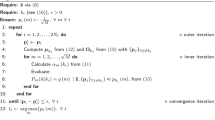Abstract
This paper is concerned with developing novel encoding techniques for implementing non-parametric neural based detectors for systems using Code Division Multiple Access. These new encoding methods on the one hand can increase the processing speed and reduce the complexity of the Feed Forward Neural Network based detector, on the other. Furthermore, we demonstrate that an asymptotically optimal detection performance can be achieved by the proposed algorithms. Due to the increased processing rate, the new scheme may further improve Spectral Efficiency. Extensive simulations and the corresponding numerical analysis demonstrate that the proposed algorithms yield near optimal performance on real channel models (COST-207).










Similar content being viewed by others
References
Bagadi, K., & Das, S. (2013). Neural network-based adaptive multiuser detection schemes in SDMA-ODFM system for wireless application. Neural Computing and Applications, 23(3–4), 1071–1082. doi:10.1007/s00521-012-1033-z.
Barahona, F. (1986). A solvable case of quadratic 0–1 programming. Discrete Applied Mathematics, 13(1), 23–26.
Cariou, L., & Helard, J. F. (2005). Mimo frequency hopping spread spectrum multi-carrier multiple access: A novel uplink system for B3G cellular networks. Telecommunication Systems, 30(1–3), 193–214. doi:10.1007/s11235-005-4325-0.
Cybenko, G. (1989). Approximation by superpositions of a sigmoidal function. Mathematics of Control, Signals and Systems, 2(4), 303–314. doi:10.1007/BF02551274.
Damen, M., El Gamal, H., & Caire, G. (2003). On maximum-likelihood detection and the search for the closest lattice point. IEEE Transactions on Information Theory, 49(10), 2389–2402. doi:10.1109/TIT.2003.817444.
Dogan, T., Zheng, J., Engelhart, A., Dangl, M., & Schummer, H. (2002). Visualization of the discrete-time channel matrix (including an animation of the transmission). http://it.e-technik.uni-ulm.de/Rdemo/index.html.
Engelhart, A., Teich, W. G., Lindner, J., Jeney, G., Imre, S., & Pap, L. (2002). A survey of multiuser/multisubchannel detection schemes based on recurrent neural networks. Wireless Communications and Mobile Computing, 2(3), 269–284.
Failli, M. (1989). Digital land mobile radio communications COST 207. Technical Report, European Commission.
Fang, S., Yunshan, S., & Liyi, Z. (2007). A novel neural network blind multi-user detection algorithm. In: Proceedings of the 2nd IEEE Conference on Industrial Electronics and Applications, ICIEA 2007, pp. 1547–1550. doi:10.1109/ICIEA.2007.4318667.
Funahashi, K.I. (1989). On the approximate realization of continuous mappings by neural networks. Neural Networks, 2(3), 183–192. doi:10.1016/0893-6080(89)90003-8 http://www.sciencedirect.com/science/article/pii/0893608089900038.
Gold, R. (1967). Optimal binary sequences for spread spectrum multiplexing (corresp.). IEEE Transactions on Information Theory, 13(4), 619–621. doi:10.1109/TIT.1967.1054048.
Haykin, S. (1994). Neural Networks: A Comprehensive Foundation. Upper Saddle River, NJ: Prentice Hall.
Haykin, S., & Moher, M. (2006). An Introduction to Analog and Digital Communications. Hoboken, NJ: Wiley.
Haykin, S. (2009). Communication Systems. Hoboken, NJ: Wiley.
He, L. (2009). A neural network blind multi-user detection algorithm. In: Proceedings of the International Conference on Measuring Technology and Mechatronics Automation, ICMTMA ’09, vol. 2, pp. 467–470. doi:10.1109/ICMTMA.2009.92.
Hornik, K., Stinchcombe, M., & White, H. (1989). Multilayer feedforward networks are universal approximators. Neural Networks, 2(5), 359–366.
Hornik, K. (1991). Approximation capabilities of multilayer feedforward networks. Neural Networks, 4(2), 251–257. doi:10.1016/0893-6080(91)90009-T.
Hung, H. L., & Huang, Y. F. (2013). Performance of multiuser detectors based on em-like method for ultra-wideband communications systems in multipath fading channel. Telecommunication Systems, pp. 1–14. doi:10.1007/s11235-013-9694-1.
Hung, H. L. (2013). Interference cancellation for HNNPSO multiuser detection of UWB systems over multipath fading channel. Telecommunication Systems, 52(2), 1191–1203. doi:10.1007/s11235-011-9634-x.
Islam, S., Ameen, M., & Kwak, K. (2013). Channel estimation in ECMA-368-based uwb systems with unknown interference. Telecommunication Systems, 52(2), 1159–1169. doi:10.1007/s11235-011-9631-0.
Jalden, J., & Ottersten, B. (2005). On the complexity of sphere decoding in digital communications. IEEE Transactions on Signal Processing, 53(4), 1474–1484. doi:10.1109/TSP.2005.843746.
Kahveci, S. (2012). A channel detection technique based on max-log-map algorithm for wireless indoor system. Telecommunication Systems, 49(4), 345–353. doi:10.1007/s11235-010-9382-3.
Larsson, E. (2009). Mimo detection methods: How they work [lecture notes]. IEEE Signal Processing Magazine, 26(3), 91–95. doi:10.1109/MSP.2009.932126.
Lee, Y., Chung, C., & Cho, S. (2000). Performance analysis of a convolutional coded ds/cdma system in nakagami fading channels. Telecommunication Systems, 14(1–4), 31–45. doi:10.1023/A:1019125029959.
Levendovszky, J., van der Meulen, E. (1998). Nonparametric bayesian estimation by feedforward neural networks. In: Proceedings of the Prague Conference on Information Theory, Statistical Decision Functions and Random Processes.
Luo, Z., Ma, W., So, A., Ye, Y., & Zhang, S. (2010). Semidefinite relaxation of quadratic optimization problems. IEEE Signal Processing Magazine, 27(3), 20–34.
Mhaskar, H. (1993). Approximation properties of a multilayered feedforward artificial neural network. Advances in Computational Mathematics, 1(1), 61–80. doi:10.1007/BF02070821.
Muzhou, H., Xuli, H., & Yixuan, G. (2009). Constructive approximation to real function by wavelet neural networks. Neural Computing and Applications, 18(8), 883–889. doi:10.1007/s00521-008-0194-2.
Özdemir, B., & Gürbüz, Z. (2013). Tomlinson–Harashima precoded mimo in wireless networks: To THP or not to THP? Telecommunication Systems pp. 1–13. doi:10.1007/s11235-013-9705-2.
Proakis, J., & Salehi, M. (2007). Digital Communications (5th ed.). New York, NY: McGraw-Hill.
Sacchi, C., & Panizza, M. (2013). Multi-rate group-orthogonal OFDMA-CDMA for broadband mobile transmission. Telecommunication Systems, 52(1), 15–29. doi:10.1007/s11235-011-9441-4.
Suzuki, S. (1997). Function approximation by three-layer artificial neural networks. In S. Ellacott, J. Mason, & I. Anderson (Eds.), Mathematics of Neural Networks, Operations Research/Computer Science Interfaces Series (vol. 8, pp. 349–354). New York, NY: Springer. doi:10.1007/978-1-4615-6099-9_61.
Tisza, D., Oláh, A., & Levendovszky, J. (2014). Novel algorithms for quadratic programming by using hypergraph representations. Wireless Personal Communications, 77(3), 2305–2339. doi:10.1007/s11277-014-1639-9.
Verdu, S. (1998). Multiuser Detection. Cambridge, MA: Cambridge University Press.
Yunshan, S., Yanqin, L., Fengmei, J., Ting, L., Liyi, Z., & Yan, Z. (2007). A novel feed-forward neural network blind multi-user detection algorithm by augmented lagrange optimization. In: Proceedings of the IET Conference on Wireless, Mobile and Sensor Networks, (CCWMSN07), pp. 8–11.
Acknowledgments
The support of the Grants TÁMOP-4.2.1.B-11/2/KMR-2011-0002 and TÁMOP-4.2.2./B-10/1-2010-0014 are gratefully acknowledged. One author (Andras Olah) would like to acknowledge the support of the Bolyai Janos Research Scholarship of the Hungarian Academy of Sciences. This work was also supported by the European Union and the European Social Fund through project FuturICT.hu (Grant no.: TAMOP-4.2.2.C-11/1/KONV-2012-0013).
Author information
Authors and Affiliations
Corresponding author
Rights and permissions
About this article
Cite this article
Tisza, D., Oláh, A. & Levendovszky, J. Multi-user detection using non-parametric Bayesian estimation by feed forward neural networks. Telecommun Syst 63, 65–75 (2016). https://doi.org/10.1007/s11235-015-9973-0
Published:
Issue Date:
DOI: https://doi.org/10.1007/s11235-015-9973-0




